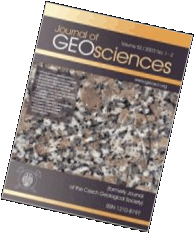Original Paper
Structural succession at Vysoky kamen in the Czech part of the southern Fichtelgebirge tectonic domain of the Central European Hercynides
Journal of the Czech Geological Society, volume 40 (1995), issue 1-2, 103 - 114
A structural succession determined in predominantly competent quartzites and psammitic schists of presumed Cambrian-Ordovician age integrates four phases of translation — slip — transposition with nine phases of folding and represents an extensive history of deformation in cover rocks in the Hercynian orogenic belt. The dominant (composite) low greenschist facies metamorphic fabric is associated with the first two recognized phases of fold formation when many tight to isoclinal folds were developed together with more open folds in fold hinge zones in the most competent units during the second phase. A less penetrative planar mineral alignment associated with the formation of recumbent folds that deform the dominant metamorphic fabric was developed after the first two recognized phases of translation (SW-directed and NE-directed), and after the formation of slip folds. The next structures in the succession represent a brittle response to potential SW-directed overthrusting. The later stages of the deformational history are recorded by at least five sets of upright folds and related weak cleavages and then by potential N-directed translation.
Integration of the phases of translation and folding into the deformational sequence established in less-competent lithologies elsewhere in the southern Fichtelgebirge tectonic domain provides a reference succession of twelve sets of folds and four sets of translation structures. This succession, and the stress systems operative during the development of the successively-formed structures, provide a basis for checking the completeness of the data that have been used in discussions of deformational, metamorphic and igneous history and for erecting dynamic models of lithospheric plate movement during the development of the Hercynian orogenic belt in Central Europe.
Webdesign inspired by aTeo. Hosted at the server of the Institute of Petrology and Structural Geology, Charles University, Prague.
ISSN: 1803-1943 (online), 1802-6222 (print)
email: jgeosci(at)jgeosci.org


IF (WoS, 2024): 1.3
5 YEAR IF (WoS, 2024): 1.4
Policy: Open Access
ISSN: 1802-6222
E-ISSN: 1803-1943
 Export to Mendeley
Export to Mendeley